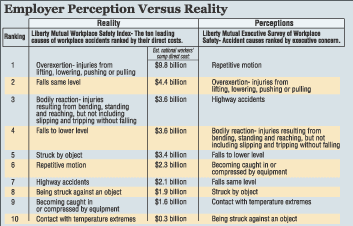Workplace Safety Pays, Survey Shows
Loss control pays, as sixty-one percent of risk management executives claim a savings of $3 or more for every $1 invested in workplace safety, a survey by Liberty Mutual has found.
Ninety-five percent of 200 risk management executives surveyed said workplace safety has a positive impact on a companys financial performance, according to the findings of the “Executive Survey of Workplace Safety” announced by Boston-based Liberty Mutual Group.
 Joseph Gilles, executive vice president of commercial markets at Liberty Mutual, said “a study like this, we believe, helps people understand the issues, understand what questions they should ask, and helps them realize that maybe they should do some research rather than just going by perceptions. Anytime people think about safety, the world gets safer.”
Joseph Gilles, executive vice president of commercial markets at Liberty Mutual, said “a study like this, we believe, helps people understand the issues, understand what questions they should ask, and helps them realize that maybe they should do some research rather than just going by perceptions. Anytime people think about safety, the world gets safer.”
The survey reveals that risk management executives believe that the benefits of workplace safety go beyond a companys bottom line. Indeed, seventy percent report that protecting employees is a leading benefit of workplace safety.
The survey helps shed light on the impact that two types of costs associated with workplace accidents are having on U.S. businesses–direct costs (payments to injured employees and their medical care providers), and indirect costs (such as lost productivity and overtime).
Of those surveyed, 93 percent see a relationship between these costs. Forty percent reported that $1 of direct costs generates between $3 and $5 of indirect costs.
By comparing the findings on indirect costs with its own research on the direct costs of workplace accidents and illness, Liberty Mutual estimates that U.S. businesses are paying between $155 billion and $232 billion annually on workers compensation losses.
Liberty Mutuals “Workplace Safety Index,” announced this spring, provides a ranking of the 10 leading causes of workplace accidents based on the direct cost of each accident category, the company noted. The Index estimated that the total direct cost of all workplace accidents was $38.7 billion in 1998–the most recent year for which data was available at the time.
Survey findings also reveal that risk management executives might be focusing attention on certain causes of workplace accidents at the expense of other causes, and may need to realign their workplace safety priorities.
Risk managers, whose job it is to “worry about and prevent losses,” should be sure to prioritize correctly, Mr. Gilles said. For example, those surveyed report that “repetitive motion” is the most important cause of workplace accidents and say they will focus workplace safety resources on this accident cause. Five other accident causes, however, each produced greater direct costs for companies in 1998, according to the Workplace Safety Index. Those were:
Overexertion.
Falls on the same level.
Injuries from bending, standing and reaching.
Falls to a lower level.
Being struck by an object.
The Index reported that workplace injuries caused by “repetitive motion” produced $2.3 billion in direct costs for employers in 1998–about a quarter of the $9.8 billion created by “overexertion,” which was the leading accident cause.
“Workplace safety has a ripple effect, either positive or negative, on so many aspects of U.S. business operations today,” Mr. Gilles said. “The first step for executives is to take preemptive measures to prevent employee pain and suffering caused by workplace injuries.”
He said this can be done by identifying those accident causes with the greatest impact on their company and focusing workplace resources on these causes.
Survey results were based on interviews with 200 executives responsible for workers' comp and commercial insurance at 125 midsize firms (with between 100 and 999 employees) and 75 large companies (over 1,000 workers) in a range of locations and industries.
Reproduced from National Underwriter Property & Casualty/Risk & Benefits Management Edition, September 17, 2001. Copyright 2001 by The National Underwriter Company in the serial publication. All rights reserved.Copyright in this article as an independent work may be held by the author.
Want to continue reading?
Become a Free PropertyCasualty360 Digital Reader
Your access to unlimited PropertyCasualty360 content isn’t changing.
Once you are an ALM digital member, you’ll receive:
- Breaking insurance news and analysis, on-site and via our newsletters and custom alerts
- Weekly Insurance Speak podcast featuring exclusive interviews with industry leaders
- Educational webcasts, white papers, and ebooks from industry thought leaders
- Critical converage of the employee benefits and financial advisory markets on our other ALM sites, BenefitsPRO and ThinkAdvisor
Already have an account? Sign In Now
© 2025 ALM Global, LLC, All Rights Reserved. Request academic re-use from www.copyright.com. All other uses, submit a request to [email protected]. For more information visit Asset & Logo Licensing.








